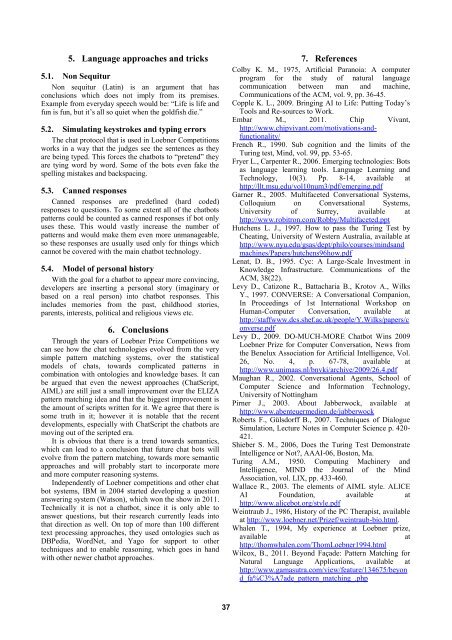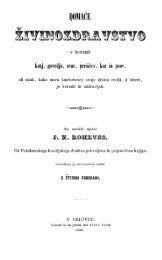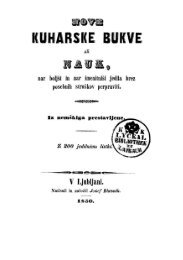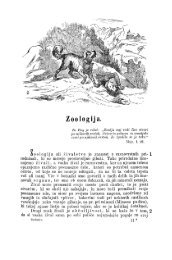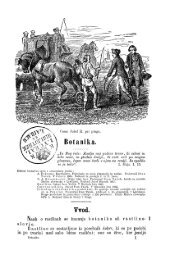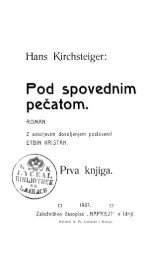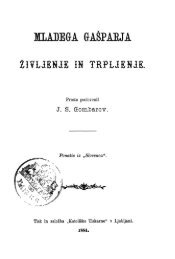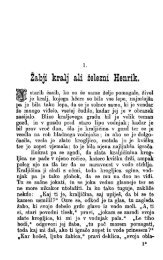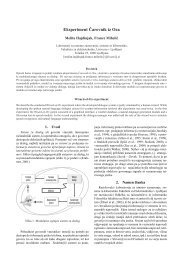Proceedings - Natural Language Server - IJS
Proceedings - Natural Language Server - IJS
Proceedings - Natural Language Server - IJS
Create successful ePaper yourself
Turn your PDF publications into a flip-book with our unique Google optimized e-Paper software.
5. <strong>Language</strong> approaches and tricks<br />
5.1. Non Sequitur<br />
Non sequitur (Latin) is an argument that has<br />
conclusions which does not imply from its premises.<br />
<br />
<br />
5.2. Simulating keystrokes and typing errors<br />
The chat protocol that is used in Loebner Competitions<br />
works in a way that the judges see the sentences as they<br />
<br />
are tying word by word. Some of the bots even fake the<br />
spelling mistakes and backspacing.<br />
5.3. Canned responses<br />
Canned responses are predefined (hard coded)<br />
responses to questions. To some extent all of the chatbots<br />
patterns could be counted as canned responses if bot only<br />
uses these. This would vastly increase the number of<br />
patterns and would make them even more unmanageable,<br />
so these responses are usually used only for things which<br />
cannot be covered with the main chatbot technology.<br />
5.4. Model of personal history<br />
With the goal for a chatbot to appear more convincing,<br />
developers are inserting a personal story (imaginary or<br />
based on a real person) into chatbot responses. This<br />
includes memories from the past, childhood stories,<br />
parents, interests, political and religious views etc.<br />
6. Conclusions<br />
Through the years of Loebner Prize Competitions we<br />
can see how the chat technologies evolved from the very<br />
simple pattern matching systems, over the statistical<br />
models of chats, towards complicated patterns in<br />
combination with ontologies and knowledge bases. It can<br />
be argued that even the newest approaches (ChatScript,<br />
AIML) are still just a small improvement over the ELIZA<br />
pattern matching idea and that the biggest improvement is<br />
the amount of scripts written for it. We agree that there is<br />
some truth in it; however it is notable that the recent<br />
developments, especially with ChatScript the chatbots are<br />
moving out of the scripted era.<br />
It is obvious that there is a trend towards semantics,<br />
which can lead to a conclusion that future chat bots will<br />
evolve from the pattern matching, towards more semantic<br />
approaches and will probably start to incorporate more<br />
and more computer reasoning systems.<br />
Independently of Loebner competitions and other chat<br />
bot systems, IBM in 2004 started developing a question<br />
answering system (Watson), which won the show in 2011.<br />
Technically it is not a chatbot, since it is only able to<br />
answer questions, but their research currently leads into<br />
that direction as well. On top of more than 100 different<br />
text processing approaches, they used ontologies such as<br />
DBPedia, WordNet, and Yago for support to other<br />
techniques and to enable reasoning, which goes in hand<br />
with other newer chatbot approaches.<br />
37<br />
7. References<br />
Colby K. M., 1975, Artificial Paranoia: A computer<br />
program for the study of natural language<br />
communication between man and machine,<br />
Communications of the ACM, vol. 9, pp. 36-45.<br />
<br />
Tools and Re-sources to Work.<br />
Embar M., 2011. Chip Vivant,<br />
http://www.chipvivant.com/motivations-andfunctionality/<br />
French R., 1990. Sub cognition and the limits of the<br />
Turing test, Mind, vol. 99, pp. 53-65.<br />
Fryer L., Carpenter R., 2006. Emerging technologies: Bots<br />
as language learning tools. <strong>Language</strong> Learning and<br />
Technology, 10(3). Pp. 8-14, available at<br />
http://llt.msu.edu/vol10num3/pdf/emerging.pdf<br />
Garner R., 2005. Multifaceted Conversational Systems,<br />
Colloquium on Conversational Systems,<br />
University of Surrey, available at<br />
http://www.robitron.com/Robby/Multifaceted.ppt<br />
Hutchens L. J., 1997. How to pass the Turing Test by<br />
Cheating, University of Western Australia, available at<br />
http://www.nyu.edu/gsas/dept/philo/courses/mindsand<br />
machines/Papers/hutchens96how.pdf<br />
Lenat, D. B., 1995. Cyc: A Large-Scale Investment in<br />
Knowledge Infrastructure. Communications of the<br />
ACM, 38(22).<br />
Levy D., Catizone R., Battacharia B., Krotov A., Wilks<br />
Y., 1997. CONVERSE: A Conversational Companion,<br />
In <strong>Proceedings</strong> of 1st International Workshop on<br />
Human-Computer Conversation, available at<br />
http://staffwww.dcs.shef.ac.uk/people/Y.Wilks/papers/c<br />
onverse.pdf<br />
Levy D., 2009. DO-MUCH-MORE Chatbot Wins 2009<br />
Loebner Prize for Computer Conversation, News from<br />
the Benelux Association for Artificial Intelligence, Vol.<br />
26, No. 4, p. 67-78, available at<br />
http://www.unimaas.nl/bnvki/archive/2009/26.4.pdf<br />
Maughan R., 2002. Conversational Agents, School of<br />
Computer Science and Information Technology,<br />
University of Nottingham<br />
Pirner J., 2003. About Jabberwock, available at<br />
http://www.abenteuermedien.de/jabberwock<br />
Roberts F., Gülsdorff B., 2007. Techniques of Dialogue<br />
Simulation, Lecture Notes in Computer Science p. 420-<br />
421.<br />
Shieber S. M., 2006, Does the Turing Test Demonstrate<br />
Intelligence or Not?, AAAI-06, Boston, Ma.<br />
Turing A.M., 1950. Computing Machinery and<br />
Intelligence, MIND the Journal of the Mind<br />
Association, vol. LIX, pp. 433-460.<br />
Wallace R., 2003. The elements of AIML style. ALICE<br />
AI Foundation, available at<br />
http://www.alicebot.org/style.pdf<br />
Weintraub J., 1986, History of the PC Therapist, available<br />
at http://www.loebner.net/Prizef/weintraub-bio.html.<br />
Whalen T., 1994, My experience at Loebner prize,<br />
available at<br />
http://thomwhalen.com/ThomLoebner1994.html<br />
Wilcox, B., 2011. Beyond Façade: Pattern Matching for<br />
<strong>Natural</strong> <strong>Language</strong> Applications, available at<br />
http://www.gamasutra.com/view/feature/134675/beyon<br />
d_fa%C3%A7ade_pattern_matching_.php


